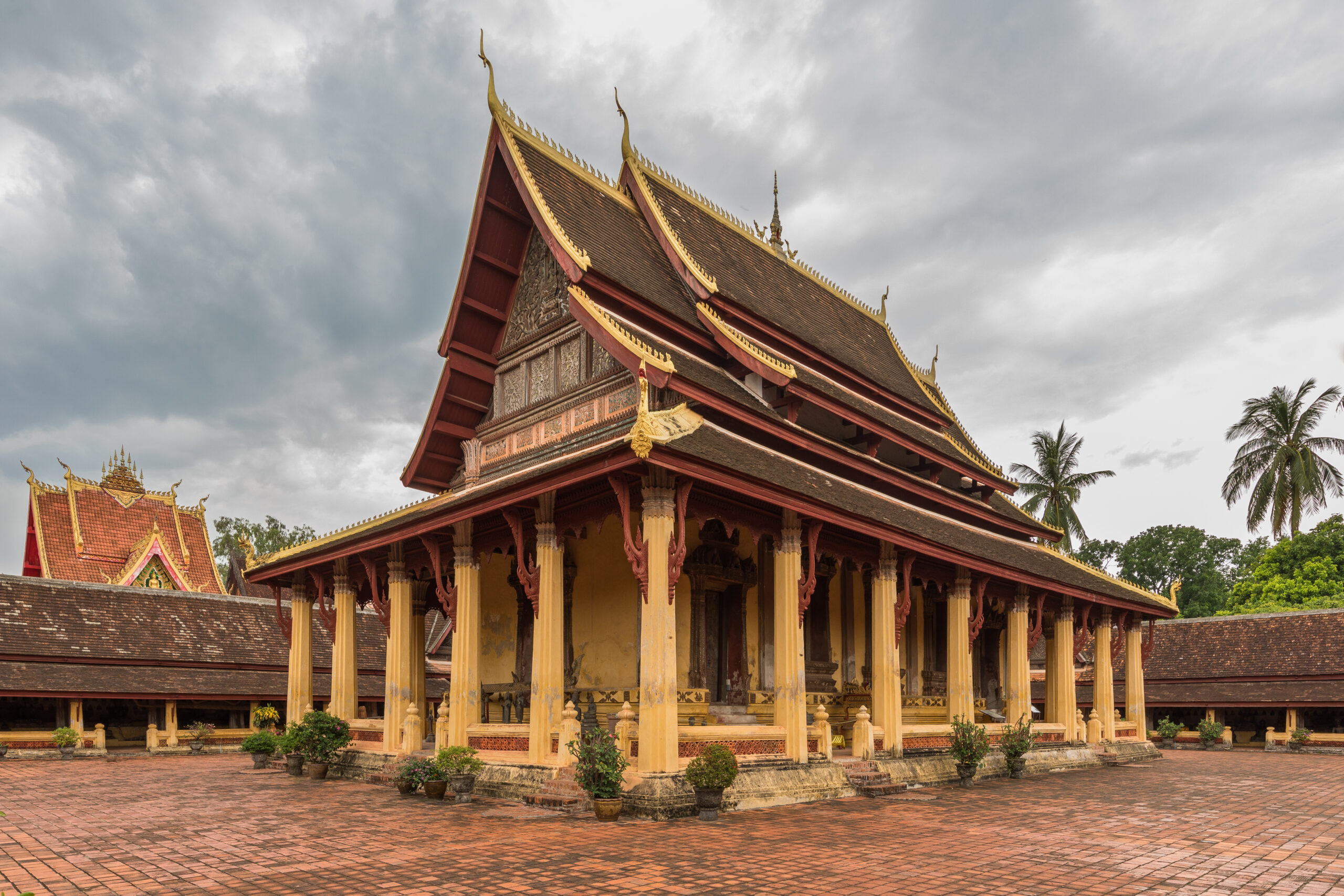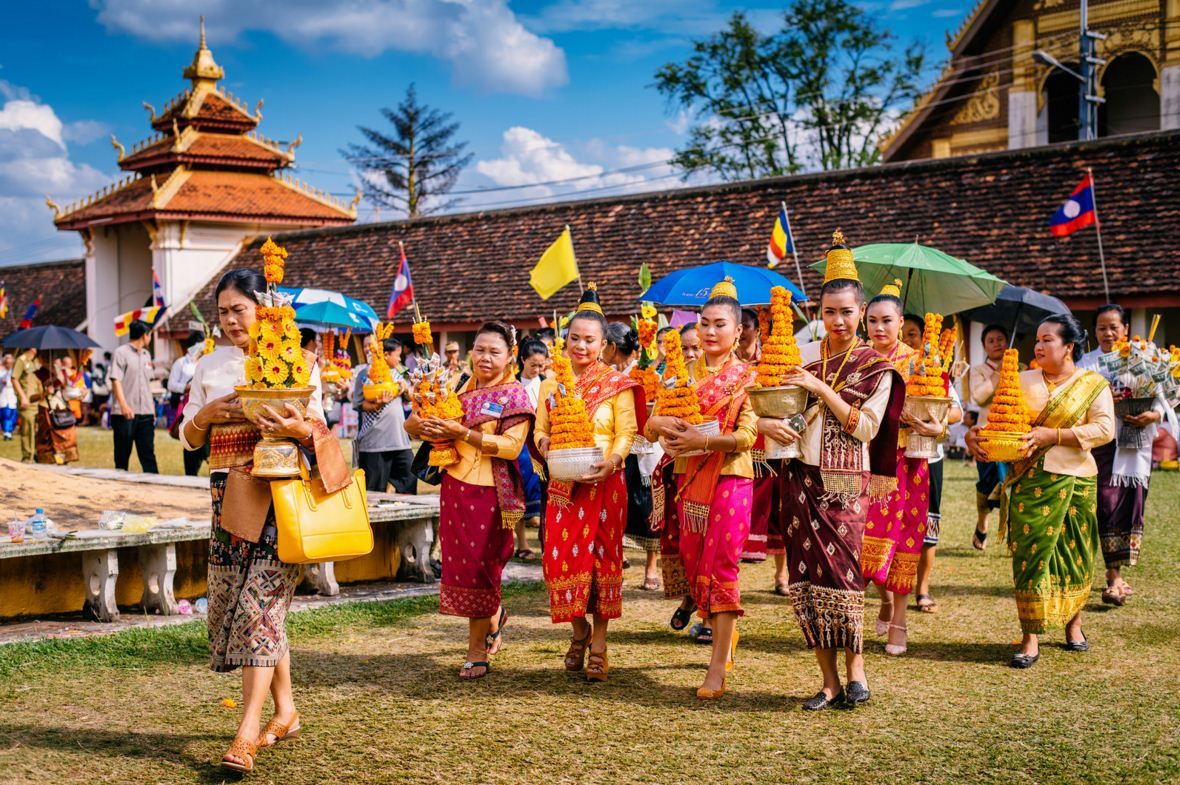1. Overview
The Baci Ceremony, also known as “Sou Khuan,” is a traditional Lao ritual performed to restore balance and harmony by calling back wandering spirits believed to protect the body. It is commonly conducted during significant life events such as weddings, births, and festivals. Visitors in Vientiane can experience this ceremony, which is deeply rooted in Lao culture and spirituality.
- Name: Baci Ceremony
- Location: Vientiane, Laos
- Coordinates: Typically central Vientiane (17.9750° N, 102.6340° E)
- Best experienced: During cultural festivals or personal milestones
2. History of the Place
- Origin: The Baci Ceremony has been practiced in Laos for centuries, with its origins rooted in animist beliefs.
- Spiritual Significance: It is based on the belief that a person’s body contains 32 khwan (spirits), and when these spirits wander, it can cause illness or misfortune.
- Purpose: The ceremony is performed to call the spirits back to restore health and well-being.
- Main Instrument: The tying of white cotton threads around the wrists is central to the ritual, symbolizing protection and well-wishing.
- Rites of Passage: Commonly performed for weddings, births, and during the Lao New Year.
- Cultural Role: The ceremony strengthens community bonds and emphasizes spiritual healing.
- Location: It is commonly performed in homes, temples, or as part of public cultural events.
- Ritual Leader: A respected elder, often a former monk, leads the ceremony with prayers and blessings.
- Festival Significance: The Baci is a highlight during Lao New Year celebrations.
3. Location
4. What Makes the “Baci Ceremony” Popular?
The Baci Ceremony is popular for its deep spiritual and cultural significance. It is not only a ritual for healing but also a communal event that strengthens social bonds. The ceremony is widely practiced during important life events, making it an essential part of Lao social life. Visitors who partake in the ceremony can gain a unique insight into Lao spirituality and customs.
- Spiritual Healing: The ceremony restores balance and health by calling back spirits.
- Cultural Tradition: It represents the deep-rooted cultural beliefs of Lao people.
- Community Bonding: The ritual encourages unity and well-wishing among participants.
5. Overall Ratings (1 to 5 Stars)
The Baci Ceremony receives high ratings for its cultural richness, emotional depth, and spiritual significance. It is a must-see experience for visitors looking to connect with Lao traditions and spiritual practices.
- Overall Rating: ⭐⭐⭐⭐⭐ (5/5)
- Cultural Impact: ⭐⭐⭐⭐⭐ (5/5)
- Spiritual Experience: ⭐⭐⭐⭐⭐ (5/5)
- Atmosphere & Environment: ⭐⭐⭐⭐☆ (4/5)
- Accessibility: ⭐⭐⭐⭐☆ (4/5)
- Tourist Friendliness: ⭐⭐⭐⭐⭐ (5/5)
6. Weather
The best time to experience the Baci Ceremony is during the dry season, when the weather is cooler and more comfortable for both outdoor and indoor activities. The ceremony is typically held indoors, so weather conditions during the wet season do not affect the ceremony itself.
- Best Time to Visit: November to February (cool and dry season)
- Temperature Range: 25–30°C (77–86°F)
- Wet Season: May to October (higher humidity and rainfall)
- Dry Season: More suitable for cultural events and outdoor activities
7. Nearest Five Hotels
For those visiting Vientiane to experience the Baci Ceremony, here are five nearby hotels that offer comfort and convenience:
- Sabaidee@Lao Hotel: Comfortable with central location
- City Inn Vientiane: Budget-friendly and close to major attractions
- Lao Plaza Hotel: Luxury with excellent amenities
- Vientiane Garden Hotel: Quiet and scenic with easy access to the city center
- Ibis Vientiane Nam Phu: Affordable and conveniently located
8. Timings
Baci Ceremonies typically take place in the evening, especially for private events like weddings or celebrations. Public ceremonies are often part of festivals and cultural events, with their timing varying depending on the occasion.
- Opening Hours: Evening ceremonies (usually 7:00 PM – 9:00 PM)
- Best Time to Visit: For personal ceremonies, evenings are ideal
- Public Ceremonies: Check local listings for specific times during festivals
9. Time Required to Visit
A typical Baci Ceremony lasts about 1 to 2 hours. The time can vary depending on the complexity of the ceremony, the number of participants, and any additional cultural events that accompany it.
- Visit Duration: 1–2 hours
- Extended Visit: 3–4 hours if part of a larger cultural event
- Ideal for a cultural evening out
10. Entry Fees & Ticket Booking Details
The Baci Ceremony often has a small fee, especially when it is part of a larger event or festival. It may also be included in cultural tours or dinner experiences at certain venues. Booking in advance is recommended for private ceremonies or festivals.
- Entry Fee: Typically 10,000–50,000 Kip ($1.00–$5.00 USD)
- Booking: Recommended for popular events or private ceremonies
- Special Events: May require early reservation through local venues or tour operators
11. Things to See & Do
During the Baci Ceremony, visitors can observe the spiritual rituals, participate in the tying of white cotton threads, and enjoy the cultural atmosphere. Traditional music and dance often accompany the ceremony, and there may be opportunities for guests to interact with local families.
- Observe the spiritual and prayer rituals
- Participate in tying the cotton threads for blessings
- Enjoy traditional Lao music and dance
- Learn about the significance of the ceremony and its cultural importance
12. Best Time to Visit
The best time to visit for a Baci Ceremony is during Lao cultural festivals such as the Lao New Year (Pi Mai Lao) or That Luang Festival, which feature large public ceremonies. The dry season (November to February) is also the best time to visit for comfortable weather.
- Best Season: November to February (dry and cool season)
- Ideal Time of Day: Evening ceremonies, especially for personal milestones
- Festivals: Attend during Lao New Year or That Luang Festival for public ceremonies
13. Nearest Parking Spots
Parking is available near most venues that host Baci Ceremonies, though space can be limited during festivals or large events. Street parking is common in Vientiane, and tuk-tuks are a convenient option for those who prefer not to drive.
- Street Parking: Available near the venue
- Public Parking: Nearby for larger venues like cultural halls
- Tuk-Tuks: Highly recommended for convenience and avoiding parking issues
14. Tips for Visitors
- Dress Modestly: Cover your shoulders and knees as a sign of respect.
- Participate Respectfully: Feel free to join the ceremony, but follow local customs and guidance.
- Ask Before Taking Photos: Be respectful of people during the ceremony, especially when photographing.
- Support Local Traditions: Consider buying traditional crafts or contributing to the community during festivals.
15. How to Reach the Place
The Baci Ceremony can be attended at various cultural venues and private homes in Vientiane. Most ceremonies are held at temples or cultural centers, which are easily accessible by tuk-tuk, bicycle, or foot from the city center.
- By Tuk-Tuk: Convenient and affordable
- By Bicycle: A popular way to explore the city
- By Taxi: Quick and comfortable for longer distances
- Walking: Convenient if staying nearby
16. Nearby Attractions to Combine for the Visit
While attending the Baci Ceremony, consider visiting nearby attractions to enhance your cultural experience. These attractions are within walking distance from the ceremony venues.
- Patuxai: The Victory Monument with scenic views of the city
- Wat Si Saket: The oldest surviving temple in Vientiane
- That Luang Stupa: Laos’ most iconic landmark
- COPE Visitor Centre: Learn about Laos’ history and the impact of unexploded ordnance
- Mekong Riverfront: Perfect for evening strolls and dining


